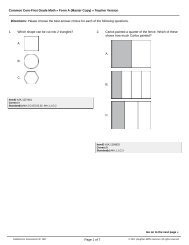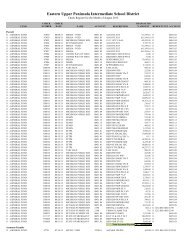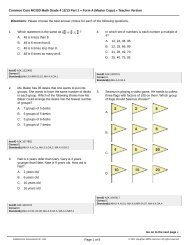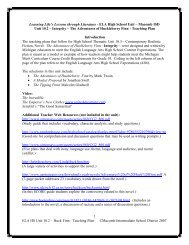Teaching Algebra with Manipulatives
Teaching Algebra with Manipulatives
Teaching Algebra with Manipulatives
Create successful ePaper yourself
Turn your PDF publications into a flip-book with our unique Google optimized e-Paper software.
Chapter<br />
6<br />
Solving Linear Inequalities<br />
<strong>Teaching</strong> Notes and Overview<br />
Using Overhead<br />
<strong>Manipulatives</strong><br />
Solving Inequalities Using Addition<br />
and Subtraction<br />
(pp. 111–113 of this booklet)<br />
Use With Lesson 6-1.<br />
Objective Model and solve inequalities using<br />
addition and subtraction.<br />
Materials<br />
inequality mat transparency*<br />
overhead counters*<br />
equation mat transparency*<br />
number line transparency*<br />
transparency pen*<br />
two blank transparencies prepared<br />
as described for the activity<br />
* available in Overhead Manipulative Resources<br />
There are two demonstrations and one<br />
extension.<br />
• Demonstration 1 involves using the Addition<br />
and Subtraction Properties for Inequality<br />
found in the Student Edition. It is important<br />
that students know how to use these<br />
properties. Displaying the properties using<br />
transparencies, as well as referencing them in<br />
the text, are beneficial to the visual learners<br />
in the class. After using the inequality mat to<br />
develop the solution to 4 x 2, write the<br />
solution set on the transparency. Make sure<br />
students understand how to read the solution<br />
set and what it means.<br />
Ask students several questions about the set<br />
to check their understanding. For example,<br />
“Is 6, a member of the set? Explain.” No,<br />
the member must be greater than 6. Some<br />
students may find it helpful to see another<br />
similar type of inequality developed and<br />
solved <strong>with</strong> the mat transparency. Use the<br />
same process for finding the solution set of<br />
2x 3 3x 7.<br />
• Demonstration 2 deals <strong>with</strong> translating a<br />
sentence containing an inequality phrase<br />
into mathematical symbols. Then the mat<br />
transparency is used to solve it. Once again,<br />
using a transparency to display the inequality<br />
chart, as well as pointing them out in the<br />
text, are needed to assist the visual learners.<br />
• The Extension involves graphing the three<br />
solution sets developed in the two<br />
demonstrations.<br />
Answers<br />
Answers appear on the teacher demonstration<br />
instructions on pages 111–113.<br />
Mini-Project<br />
Multiplying Inequalities by 1<br />
(p. 114 of this booklet)<br />
Use With Lesson 6-1.<br />
Objective Multiplying inequalities by 1.<br />
This project requires students to work <strong>with</strong> a<br />
partner. They are asked to read and understand<br />
the three examples, and then do exercises that<br />
check on their understanding. It is essential<br />
that students know that when an inequality is<br />
multiplied by 1, the sense of the inequality<br />
must change.<br />
Answers<br />
1. x 2 2. x 5<br />
3. x 6 4. x 7<br />
5. x 4 6. x 8<br />
7. x 10 8. x 0<br />
9. ; <br />
10. The direction of the inequality symbol must<br />
be reversed.<br />
<strong>Algebra</strong> Activity<br />
Recording Sheet<br />
Solving Inequalities<br />
(p. 115 of this booklet)<br />
Use With Lesson 6-2 as a preview activity.<br />
This corresponds to the activity on page 324 in<br />
the Student Edition.<br />
Objective Solving inequalities.<br />
© Glencoe/McGraw-Hill 108 <strong>Teaching</strong> <strong>Algebra</strong> <strong>with</strong> <strong>Manipulatives</strong>







